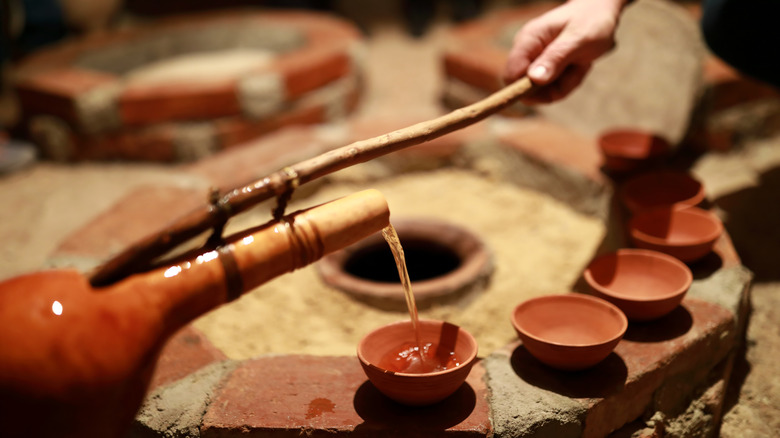How The Hue Of Orange Wine Determines Its Flavor Profile
We may receive a commission on purchases made from links.
For the longest time, the only options on most American wine lists were red and white, with rosé a more recent common addition. But now there's a new kid on the block — orange wine. Essentially, orange wine is a white wine that's been fermented with grape skins, per Thrillist. By comparison, white wine is made by fermenting just the grape's juices. Adding in the skins contributes tannins and other compounds that are more often associated with red wines, but monitoring the number of ingredients and fermentation times can help to retain some of white wine's typical qualities.
This might sound similar to a rosé wine because it is. VinePair reports that the only difference between these two styles is the type of grape used. Rosé uses red wine grapes, while orange uses white wine grapes. Both styles use grape skins to add color and other qualities to what would otherwise be a lighter wine.
Wine Enthusiast says that orange wines have been a longstanding tradition in Georgia and other European countries, but have been riding on the popularity of organic wines in recent years. Because the skins act as a preservative and antioxidant, they can help assist the needs of natural wine manufacturers. This wine goes particularly well with practically any meal, as a balanced orange can complement a wide range of foods and flavors.
History of orange wine production
According to Thrillist, what we now call orange wine has been popular in the country of Georgia for centuries. In fact, Georgia claims to be the first nation to cultivate wine at all, meaning that this style of production could be as old as the concept of wine itself.
Wine in Georgia is typically made in a clay vessel known as a qvevri. These are kept underground in cellars where consistent temperatures allow for a controlled fermentation rate. Archaeological reports have found these vessels date back as far as 8,000 years ago. In Georgia, this style of wine is often referred to as amber wine. According to Thrillist, there is even a movement to refer to Georgian qvevri-made wines solely as amber instead of orange.
While this tradition may be older than the Colosseum, its global spread only began about 20 years ago. MasterClass reports that, in the early 2000s, two winemakers from Italy visited Georgia. They returned with qvevri of their own to start producing orange wines. Thrillist points out that Georgian wines themselves have seen a resurgence as well. Some producers have brought back traditional grapes like the Krakuna varietal to use exclusively in their amber wines.
What does the color of orange wine really tell you?
One of the most striking features of an orange wine is, of course, its color. We're used to seeing and describing wines as golden, pink, violet, burgundy, and everything in between. Yet, many of us skip over the orange hues of the color wheel. We should pay attention, however, as that orange color is going to tell you quite a lot about a wine's characteristics, just like any other vintage.
VinePair notes that because of the way orange wines are made, the color carries a lot of info about a wine's manufacturing process. The color of the orange wine is derived from coming into contact with grape skins. Broadly speaking, the more time a mix spends in contact with the skins, the darker the color will be.
Eataly points out that these skins contain the tannins, aromas, and flavor compounds that make the orange wine so distinct and even affect the texture. Paler orange wines will be closer to white wines in flavor and texture, but with additional bold flavors. A deeper amber-colored wine will have more texture and a more pronounced flavor as well. Orange wines run the gamut in terms of color the same as white, red, or pink wines. That means that half the fun is trying as many as you can to find which flavors and colors suit your tastes best.


